Investigating Hydrological Drought Characteristics in Northeastern Thailand in CMIP5 Climate Change Scenarios
Abstract
:1. Introduction
2. Materials and Methods
2.1. Study Area
2.2. Data Collection
2.2.1. Meteorological Data
2.2.2. Hydrological Data
2.2.3. Topographic, Soil, and Land Use Data
2.3. Methodology
2.3.1. Global Climate Models (GCMs) and Climate Scenarios
2.3.2. SWAT Model
- (1)
- Model Description
- (2)
- Model Setup
- (3)
- Model Evaluation
2.3.3. Hydrological Drought Index
2.3.4. Scenarios Analysis in Different Return Periods
3. Results
3.1. Calibration and Validation of SWAT Model
3.2. Identification of Historical Drought Characteristics
3.3. Assessment of Climate Change Impacts on Hydrological Drought
3.3.1. The Selection of the Fittest GCM
3.3.2. Future Rainfall
3.3.3. Future Streamflow
3.3.4. Future Hydrological Drought Characteristics
3.3.5. Analysis of SDI in Different Return Periods
4. Discussion
4.1. Trends in Future Rainfall
4.2. Effects on Future Streamflow
4.3. Characteristics of Hydrological Drought
4.4. Management Implications and Future Perspectives
5. Conclusions
Author Contributions
Funding
Institutional Review Board Statement
Informed Consent Statement
Data Availability Statement
Acknowledgments
Conflicts of Interest
References
- Swain, D.L.; Singh, D.; Touma, D.; Diffenbaugh, N.S. Attributing Extreme Events to Climate Change: A New Frontier in a Warming World. One Earth 2020, 2, 522–527. [Google Scholar] [CrossRef]
- Bates, B.; Kundzewicz, Z.W.; Wu, S.; Burkett, V.; Doell, P.; Gwary, D.; Hanson, C.; Heij, B.; Jiménez, B.; Kaser, G.; et al. Climate Change and Water. Tech. Pap. Intergov. Panel Clim. Chang. 2008. [Google Scholar] [CrossRef]
- Wilhite, D.A.; Glantz, M.H. Understanding: The Drought Phenomenon: The Role of Definitions. Water Int. 1985, 10, 111–120. [Google Scholar] [CrossRef]
- Secci, D.; Tanda, M.G.; D’Oria, M.; Todaro, V.; Fagandini, C. Impacts of Climate Change on Groundwater Droughts by Means of Standardized Indices and Regional Climate Models. J. Hydrol. 2021, 603, 127154. [Google Scholar] [CrossRef]
- Jehanzaib, M.; Shah, S.A.; Yoo, J.-Y.; Kim, T.-W. Investigating the Impacts of Climate Change and Human Activities on Hydrological Drought Using Non-Stationary Approaches. J. Hydrol. 2020, 588, 125052. [Google Scholar] [CrossRef]
- Vargas, J.; Paneque, P. Challenges for the Integration of Water Resource and Drought-Risk Management in Spain. Sustainability 2019, 11, 3356. [Google Scholar] [CrossRef]
- Jahangir, M.H.; Yarahmadi, Y. Hydrological Drought Analyzing and Monitoring by Using Streamflow Drought Index (SDI) (Case Study: Lorestan, Iran). Arab. J. Geosci. 2020, 13, 110. [Google Scholar] [CrossRef]
- Meilutytė-Lukauskienė, D.; Nazarenko, S.; Kobets, Y.; Akstinas, V.; Sharifi, A.; Haghighi, A.T.; Hashemi, H.; Kokorīte, I.; Ozolina, B. Hydro-Meteorological Droughts Across the Baltic Region: The Role of the Accumulation Periods. Sci. Total Environ. 2024, 913, 169669. [Google Scholar] [CrossRef]
- Athukoralalage, D.; Brookes, J.; McDowell, R.W.; Mosley, L.M. Impact of Hydrological Drought Occurrence, Duration, and Severity on Murray-Darling Basin Water Quality. Water Res. 2024, 252, 121201. [Google Scholar] [CrossRef]
- Wubneh, M.A.; Alemu, M.G.; Fekadie, F.T.; Worku, T.A.; Demamu, M.T.; Aman, T.F. Meteorological and Hydrological Drought Monitoring and Trend Analysis for Selected Gauged Watersheds in the Lake Tana Basin, Ethiopia: Under Future Climate Change Impact Scenario. Sci. Afr. 2023, 20, e01738. [Google Scholar] [CrossRef]
- Malik, A.; Kumar, A.; Singh, R.P. Application of Heuristic Approaches for Prediction of Hydrological Drought Using Multi-Scalar Streamflow Drought Index. Water Resour. Manag. 2019, 33, 3985–4006. [Google Scholar] [CrossRef]
- Katipoğlu, O.M. Prediction of Streamflow Drought Index for Short-Term Hydrological Drought in the Semi-Arid Yesilirmak Basin Using Wavelet Transform and Artificial Intelligence Techniques. Sustainability 2023, 15, 4507. [Google Scholar] [CrossRef]
- Boonwichai, S.; Shrestha, S.; Pradhan, P.; Babel, M.S.; Datta, A. Adaptation Strategies for Rainfed Rice Water Management under Climate Change in Songkhram River Basin, Thailand. J. Water Clim. Chang. 2021, 12, 2181–2198. [Google Scholar] [CrossRef]
- Sangkhaphan, S.; Shu, Y. The Effect of Rainfall on Economic Growth in Thailand: A Blessing for Poor Provinces. Economies 2020, 8, 37. [Google Scholar] [CrossRef]
- Intergovernmental Panel on Climate Change (IPCC). Observations: Atmosphere and Surface. In Climate Change 2013—The Physical Science Basis: Working Group I Contribution to the Fifth Assessment Report of the Intergovernmental Panel on Climate Change; Cambridge University Press: Cambridge, UK, 2014; pp. 159–254. [Google Scholar]
- Hormwichian, R.; Kaewplang, S.; Kangrang, A.; Supakosol, J.; Boonrawd, K.; Sriworamat, K.; Muangthong, S.; Songsaengrit, S.; Prasanchum, H. Understanding the Interactions of Climate and Land Use Changes with Runoff Components in Spatial-Temporal Dimensions in the Upper Chi Basin, Thailand. Water 2023, 15, 2022. [Google Scholar] [CrossRef]
- Liu, S.; Chen, J.; Li, J.; Li, T.; Shi, H.; Sivakumar, B. Building a Large Dam: Identifying the Relationship Between Catchment Area and Slope Using the Confidence Ellipse Approach. Geosci. Lett. 2023, 10, 4. [Google Scholar] [CrossRef]
- Dlamini, T.; Songsom, V.; Koedsin, W.; Ritchie, R.J. Intensity, Duration, and Spatial Coverage of Aridity During Meteorological Drought Years Over Northeast Thailand. Climate 2022, 10, 35. [Google Scholar] [CrossRef]
- Prasanchum, H.; Pimput, Y. Risk Assessment of Flash Flood Situation Under Land Use Change Using Daily SWAT Streamflow Simulation in Loei Basin, Northeastern Thailand. IOP Conf. Ser. Earth Environ. Sci. 2023, 1151, 012015. [Google Scholar] [CrossRef]
- Plaiklang, S.; Sutthivanich, I.; Sritarapipat, T.; Panurak, K.; Ogawa, S.; Charungthanakij, S.; Maneewan, U.; Thongrueang, N. Desertification Assessment Using MEDALUS Model in Upper Lamchiengkrai Watershed, Thailand. Int. Arch. Photogramm. Remote Sens. Spatial Inf. Sci. 2020, XLIII, 1257–1262. [Google Scholar] [CrossRef]
- Zhang, T.; Su, X.; Zhang, G.; Wu, H.; Liu, Y. Projections of the Characteristics and Probability of Spatially Concurrent Hydrological Drought in a Cascade Reservoirs Area Under CMIP6. J. Hydrol. 2022, 613, 128472. [Google Scholar] [CrossRef]
- Royal Irrigation Department. Developing Water Resources to Solve Drought and Flood Problems in the Lam Chiang Krai Watershed. Available online: https://www.undp.org/thailand/press-releases/undp-and-royal-irrigation-department-thailand-marks-world-water-day-2023-new-gcf-funded-project (accessed on 23 April 2023).
- Nabinejad, S.; Schüttrumpf, H. Flood Risk Management in Arid and Semi-Arid Areas: A Comprehensive Review of Challenges, Needs, and Opportunities. Water 2023, 15, 1070. [Google Scholar] [CrossRef]
- Northeastern Meteorological Center (Lower Part). Daily Meteorological Data, Including Precipitation, Temperature, Humidity, Wind Speed, and Radiation. Available online: https://ubonmet.tmd.go.th/ (accessed on 20 April 2022).
- Yamada, I. Thiessen Polygons. In International Encyclopedia of Geography; Wiley: Hoboken, NJ, USA, 2016; pp. 1–6. [Google Scholar]
- Royal Irrigation Department. Thailand Daily Hydrological Data, Including Streamflow. Available online: https://water.rid.go.th/hydrology/ (accessed on 20 April 2023).
- National Aeronautics and Space Administration (NASA). Earth Science Data Systems (ESDS) Program. Available online: https://search.asf.alaska.edu/#/ (accessed on 10 January 2022).
- Kamworapan, S.; Surussavadee, C. Evaluation of CMIP5 Global Climate Models for Simulating Climatological Temperature and Precipitation for Southeast Asia. Adv. Meteorol. 2019, 2019, 1067365. [Google Scholar] [CrossRef]
- Chung, J.X.; Juneng, L.; Santisirisomboon, G.; Ngo-Duc, T.; Phan-Van, T.; Trinh-Tuan, L.; Cruz, F.; Dado, J.; Srisawadwong, R.; Gunawan, D.; et al. Future Changes in Mean and Extreme Precipitation Over Peninsular Malaysia Using CORDEX-SEA 5 km Simulations. APN Sci. Bull. 2023, 13, 263–276. [Google Scholar] [CrossRef]
- Lee, Z.H.; Sethupathi, S.; Lee, K.T.; Bhatia, S.; Mohamed, A.R. An Overview on Global Warming in Southeast Asia: CO2 Emission Status, Efforts Done, and Barriers. Renew. Sustain. Energy Rev. 2013, 28, 71–81. [Google Scholar] [CrossRef]
- Sentian, J.; Payus, C.M.; Herman, F.; Kong, V.W.Y. Climate Change Scenarios Over Southeast Asia. APN Sci. Bull. 2022, 12, 102–122. [Google Scholar] [CrossRef]
- Schwalm, C.R.; Glendon, S.; Duffy, P.B. RCP8.5 Tracks Cumulative CO2 Emissions. Proc. Natl. Acad. Sci. USA 2020, 117, 19656–19657. [Google Scholar] [CrossRef]
- Thomson, A.M.; Calvin, K.V.; Smith, S.J.; Kyle, G.P.; Volke, A.; Patel, P.; Delgado-Arias, S.; Bond-Lamberty, B.; Wise, M.A.; Clarke, L.E.; et al. RCP4.5: A Pathway for Stabilization of Radiative Forcing by 2100. Clim. Chang. 2011, 109, 77–94. [Google Scholar] [CrossRef]
- Kotamarthi, R.; Hayhoe, K.; Mearns, L.O.; Wuebbles, D.; Jacobs, J.; Jurado, J. Dynamical Downscaling. In Downscaling Techniques for High-Resolution Climate Projections: From Global Change to Local Impacts; Cambridge University Press: Cambridge, UK, 2021; pp. 64–81. [Google Scholar]
- Zhou, Q.; Chen, D.; Hu, Z.-Y.; Chen, X. Decompositions of Taylor Diagram and DISO Performance Criteria. Int. J. Climatol. 2021, 41, 4195–4210. [Google Scholar] [CrossRef]
- Gassman, P.W.; Sadeghi, A.M.; Srinivasan, R. Applications of the SWAT Model Special Section: Overview and Insights. J. Environ. Qual. 2014, 43, 1–8. [Google Scholar] [CrossRef]
- Abbaspour, K.C.; Yang, J.; Maximov, I.; Siber, R.; Bogner, K.; Mieleitner, J.; Zobrist, J.; Srinivasan, R. Modelling Hydrology and Water Quality in the Pre-Alpine/Alpine Thur Watershed Using SWAT. J. Hydrol. 2007, 333, 413–430. [Google Scholar] [CrossRef]
- Aawar, T.; Khare, D. Assessment of Climate Change Impacts on Streamflow through Hydrological Model Using SWAT Model: A Case Study of Afghanistan. Model. Earth Syst. Environ. 2020, 6, 1427–1437. [Google Scholar] [CrossRef]
- Moriasi, D.N.; Arnold, J.G.; Van Liew, M.W.; Bingner, R.L.; Harmel, R.D.; Veith, T.L. Model Evaluation Guidelines for Systematic Quantification of Accuracy in Watershed Simulations. Trans. ASABE 2007, 50, 885–900. [Google Scholar] [CrossRef]
- Nash, J.E.; Sutcliffe, J.V. River Flow Forecasting Through Conceptual Models Part I—A Discussion of Principles. J. Hydrol. 1970, 10, 282–290. [Google Scholar] [CrossRef]
- Arnold, J.G.; Moriasi, D.N.; Gassman, P.W.; Abbaspour, K.C.; White, M.J.; Srinivasan, R.; Santhi, C.; Harmel, R.D.; van Griensven, A.; Van Liew, M.W.; et al. SWAT: Model Use, Calibration, and Validation. Trans. ASABE 2012, 55, 1491–1508. [Google Scholar] [CrossRef]
- Gupta, H.V.; Sorooshian, S.; Yapo, P.O. Status of Automatic Calibration for Hydrologic Models: Comparison with Multilevel Expert Calibration. J. Hydrol. Eng. 1999, 4, 135–143. [Google Scholar] [CrossRef]
- Gupta, H.V.; Kling, H.; Yilmaz, K.K.; Martinez, G.F. Decomposition of the Mean Squared Error and NSE Performance Criteria: Implications for Improving Hydrological Modelling. J. Hydrol. 2009, 377, 80–91. [Google Scholar] [CrossRef]
- Nalbantis, I.; Tsakiris, G. Assessment of Hydrological Drought Revisited. Water Resour. Manag. 2009, 23, 881–897. [Google Scholar] [CrossRef]
- McKee, T.B.; Doesken, N.J.; Kleist, J. The Relationship of Drought Frequency and Duration to Time Scales. In Preprints, 8th Conference on Applied Climatology; American Meteorological Society: Boston, MA, USA, 1993; pp. 179–184. [Google Scholar]
- Yevjevich, V.M. An Objective Approach to Definitions and Investigations of Continental Hydrologic Droughts; Colorado State University: Fort Collins, CO, USA, 1967; Volume 23. [Google Scholar]
- Guo, H.; Bao, A.; Liu, T.; Ndayisaba, F.; He, D.; Kurban, A.; De Maeyer, P. Meteorological Drought Analysis in the Lower Mekong Basin Using Satellite-Based Long-Term CHIRPS Product. Sustainability 2017, 9, 901. [Google Scholar] [CrossRef]
- Ghabelnezam, E.; Mostafazadeh, R.; Hazbavi, Z.; Huang, G. Hydrological Drought Severity in Different Return Periods in Rivers of Ardabil Province, Iran. Sustainability 2023, 15, 2547. [Google Scholar] [CrossRef]
- Altunkaynak, A.; Wang, K.-H. Triple Diagram Models for Prediction of Suspended Solid Concentration in Lake Okeechobee, Florida. J. Hydrol. 2010, 387, 165–175. [Google Scholar] [CrossRef]
- Mostafazadeh, R.; Shahabi, M.; Zabihi, M. Analysis of Meteorological Drought Using Triple Diagram Model in the Kurdistan Province, Iran. Geogr. Plan. Space Q. J. 2015, 5, 129–140. [Google Scholar]
- Pimonsree, S.; Kamworapan, S.; Gheewala, S.H.; Thongbhakdi, A.; Prueksakorn, K. Evaluation of CMIP6 GCMs Performance to Simulate Precipitation Over Southeast Asia. Atmos. Res. 2023, 282, 106522. [Google Scholar] [CrossRef]
- Tangang, F.; Santisirisomboon, J.; Juneng, L.; Salimun, E.; Chung, J.; Supari, S.; Cruz, F.; Ngai, S.T.; Ngo-Duc, T.; Singhruck, P.; et al. Projected Future Changes in Mean Precipitation Over Thailand Based on Multi-Model Regional Climate Simulations of CORDEX Southeast Asia. Int. J. Climatol. 2019, 39, 5413–5436. [Google Scholar] [CrossRef]
- Maimone, M.; Malter, S.; Anbessie, T.; Rockwell, J. Three Methods of Characterizing Climate-Induced Changes in Extreme Rainfall: A Comparison Study. J. Water Clim. Chang. 2023, 14, 4245–4260. [Google Scholar] [CrossRef]
- Khalil, A. Combined Use of Graphical and Statistical Approaches for Rainfall Trend Analysis in the Mae Klong River Basin, Thailand. J. Water Clim. Chang. 2023, 14, 4642–4668. [Google Scholar] [CrossRef]
- Tammadid, W.; Nantasom, K.; Sirksiri, W.; Vanitchung, S.; Promjittiphong, C.; Limsakul, A.; Hanpattanakit, P. Future Projections of Precipitation and Temperature in Northeast Thailand Using Bias-Corrected Global Climate Models. Chiang Mai J. Sci. 2023, 50, 1–8. [Google Scholar] [CrossRef]
- Boonwichai, S.; Shrestha, S. Climate Change Impact on Rained Rice Production and Irrigation Water Requirement in Songkhram River Basin, Thailand. Int. J. Eng. Technol. Sci. 2018, 5, 94–104. [Google Scholar]
- Li, C.; Fang, H. Assessment of Climate Change Impacts on the Streamflow for the Mun River in the Mekong Basin, Southeast Asia: Using SWAT Model. CATENA 2021, 201, 105199. [Google Scholar] [CrossRef]
- Allen, S.K.; Barros, V.; Burton, I.; Campbell-Lendrum, D.; Cardona, O.-D.; Cutter, S.L.; Dube, O.P.; Ebi, K.L.; Field, C.B.; Handmer, J.W.; et al. Summary for Policymakers. In Managing the Risks of Extreme Events and Disasters to Advance Climate Change Adaptation: Special Report of the Intergovernmental Panel on Climate Change; Cambridge University Press: Cambridge, UK, 2012; pp. 3–22. [Google Scholar]
- Shrestha, S.; Roachanakanan, R. Extreme Climate Projections Under Representative Concentration Pathways in the Lower Songkhram River Basin, Thailand. Heliyon 2021, 7, e06146. [Google Scholar] [CrossRef]
- Okwala, T.; Shrestha, S.; Ghimire, S.; Mohanasundaram, S.; Datta, A. Assessment of Climate Change Impacts on Water Balance and Hydrological Extremes in Bang Pakong-Prachin Buri River Basin, Thailand. Environ. Res. 2020, 186, 109544. [Google Scholar] [CrossRef]
- Orkodjo, T.P.; Kranjac-Berisavijevic, G.; Abagale, F.K. Impact of Climate Change on Future Precipitation Amounts, Seasonal Distribution, and Streamflow in the Omo-Gibe Basin, Ethiopia. Heliyon 2022, 8, e09711. [Google Scholar] [CrossRef] [PubMed]
- Promping, T.; Tingsanchali, T.; Chuanpongpanich, S. Impacts of Future Climate Change on Inflow to Pasak Jolasid Dam in Pasak River Basin, Thailand. Water Environ. J. 2021, 35, 1355–1369. [Google Scholar]
- Kimmany, B.; Visessri, S.; Pech, P.; Ekkawatpanit, C. The Impact of Climate Change on Hydro-Meteorological Droughts in the Chao Phraya River Basin, Thailand. Water 2024, 16, 100. [Google Scholar] [CrossRef]
- Tuccella, P.; Menut, L.; Briant, R.; Deroubaix, A.; Khvorostyanov, D.; Mailler, S.; Siour, G.; Turquety, S. Implementation of Aerosol-Cloud Interaction Within WRF-CHIMERE Online Coupled Model: Evaluation and Investigation of the Indirect Radiative Effect from Anthropogenic Emission Reduction on the Benelux Union. Atmosphere 2019, 10, 543. [Google Scholar] [CrossRef]
- Gryspeerdt, E.; Smith, T.W.P.; O’Keeffe, E.; Christensen, M.W.; Goldsworth, F.W. The Impact of Ship Emission Controls Recorded by Cloud Properties. Geophys. Res. Lett. 2019, 46, 12547–12555. [Google Scholar] [CrossRef]
- Rosenfeld, D.; Lohmann, U.; Raga, G.; O’Dowd, C.; Kulmala, M.; Sandro, F.; Reissell, A.; Andreae, M. Flood or Drought: How Do Aerosols Affect Precipitation? Science 2008, 321, 1309–1313. [Google Scholar] [CrossRef]
- Intergovernmental Panel on Climate Change (IPCC). Climate Change 2021—The Physical Science Basis: Working Group I Contribution to the Sixth Assessment Report of the Intergovernmental Panel on Climate Change; Cambridge University Press: Cambridge, UK, 2023. [Google Scholar]
- Kabir, M.; Habiba, U.E.; Khan, W.; Shah, A.; Rahim, S.; Rios-Escalante, P.R.D.L.; Farooqi, Z.-U.-R.; Ali, L.; Shafiq, M. Climate Change Due to Increasing Concentration of Carbon Dioxide and Its Impacts on Environment in 21st Century: A Mini Review. J. King Saud. Univ. Sci. 2023, 35, 102693. [Google Scholar] [CrossRef]
- Satoh, Y.; Yoshimura, K.; Pokhrel, Y.; Kim, H.; Shiogama, H.; Yokohata, T.; Hanasaki, N.; Wada, Y.; Burek, P.; Byers, E.; et al. The Timing of Unprecedented Hydrological Drought Under Climate Change. Nat. Commun. 2022, 13, 3287. [Google Scholar] [CrossRef]
- Ullah, I.; Xinmin, Z.; Hina, S.; Syed, S.; Ma, X.; Iyakaremye, V.; Yin, J.; Singh, V. Recent and Projected Changes in Water Scarcity and Unprecedented Drought Events Over Southern Pakistan. Front. Earth Sci. 2023, 11, 977460. [Google Scholar]
- Xu, Y.; Zhang, X.; Hao, Z.; Hao, F.; Li, C. Systematic Assessment of the Development and Recovery Characteristics of Hydrological Drought in a Semi-Arid Area. Sci. Total Environ. 2022, 836, 155472. [Google Scholar] [CrossRef]
- Maithong, P.; Mapiam, P.P.; Lipiwattanakarn, S. Spatial Distribution of Drought Return Periods for the Mun Basin Using a Bivariate Copula Method. J. King Mongkut’s Univ. Technol. North Bangk. 2018, 28, 126–134. [Google Scholar] [CrossRef]
- Akbari, M.; Mirchi, A.; Roozbahani, A.; Gafurov, A.; Kløve, B.; Haghighi, A.T. Desiccation of the Transboundary Hamun Lakes Between Iran and Afghanistan in Response to Hydro-Climatic Droughts and Anthropogenic Activities. J. Great Lakes Res. 2022, 48, 876–889. [Google Scholar] [CrossRef]
- Parchami, N.; Mostafazadeh, R.; Ouri, A.E.; Imani, R. Spatio-Temporal Analysis of River Flow Master Recession Curve Characteristics Over Ardabil Province Rivers. Phys. Chem. Earth Parts A/B/C 2024, 134, 103586. [Google Scholar] [CrossRef]
- Hasan, H.H.; Razali, S.F.; Muhammad, N.S.; Ahmad, A. Modified Hydrological Drought Risk Assessment Based on Spatial and Temporal Approaches. Sustainability 2022, 14, 11235. [Google Scholar] [CrossRef]
- Fung, K.F.; Huang, Y.F.; Koo, C.H. Investigation of Streamflow as a Seasonal Hydrological Drought Indicator for a Tropical Region. Water Supply 2020, 20, 609–620. [Google Scholar] [CrossRef]
- Tareke, K.A.; Awoke, A.G. Comparing Surface Water Supply Index and Streamflow Drought Index for Hydrological Drought Analysis in Ethiopia. Heliyon 2022, 8, e12000. [Google Scholar] [CrossRef]
- Fabian, P.S.; Kwon, H.-H.; Vithanage, M.; Lee, J.-H. Modeling, Challenges, and Strategies for Understanding Impacts of Climate Extremes (Droughts and Floods) on Water Quality in Asia: A Review. Environ. Res. 2023, 225, 115617. [Google Scholar] [CrossRef]
- Wu, X.; Shen, X.; Wei, C.; Xie, X.; Li, J. Reservoir Operation Sequence- and Equity Principle-Based Multi-Objective Ecological Operation of Reservoir Group: A Case Study in a Basin of Northeast China. Sustainability 2022, 14, 10826. [Google Scholar] [CrossRef]
- Shang, Z.; Abdalla, M.; Xia, L.; Zhou, F.; Sun, W.; Smith, P. Can Cropland Management Practices Lower Net Greenhouse Emissions Without Compromising Yield? Glob. Chang. Biol. 2021, 27, 4657–4670. [Google Scholar] [CrossRef]
- Prakongsri, P.; Santiboon, T. Effective Water Resources Management for Communities in the Chi River Basin in Thailand. Environ. Claims J. 2020, 32, 323–348. [Google Scholar] [CrossRef]
- Begna, T. Impact of Drought Stress on Crop Production and Its Management Options. Int. J. Res. Agron. 2021, 4, 66–74. [Google Scholar] [CrossRef]
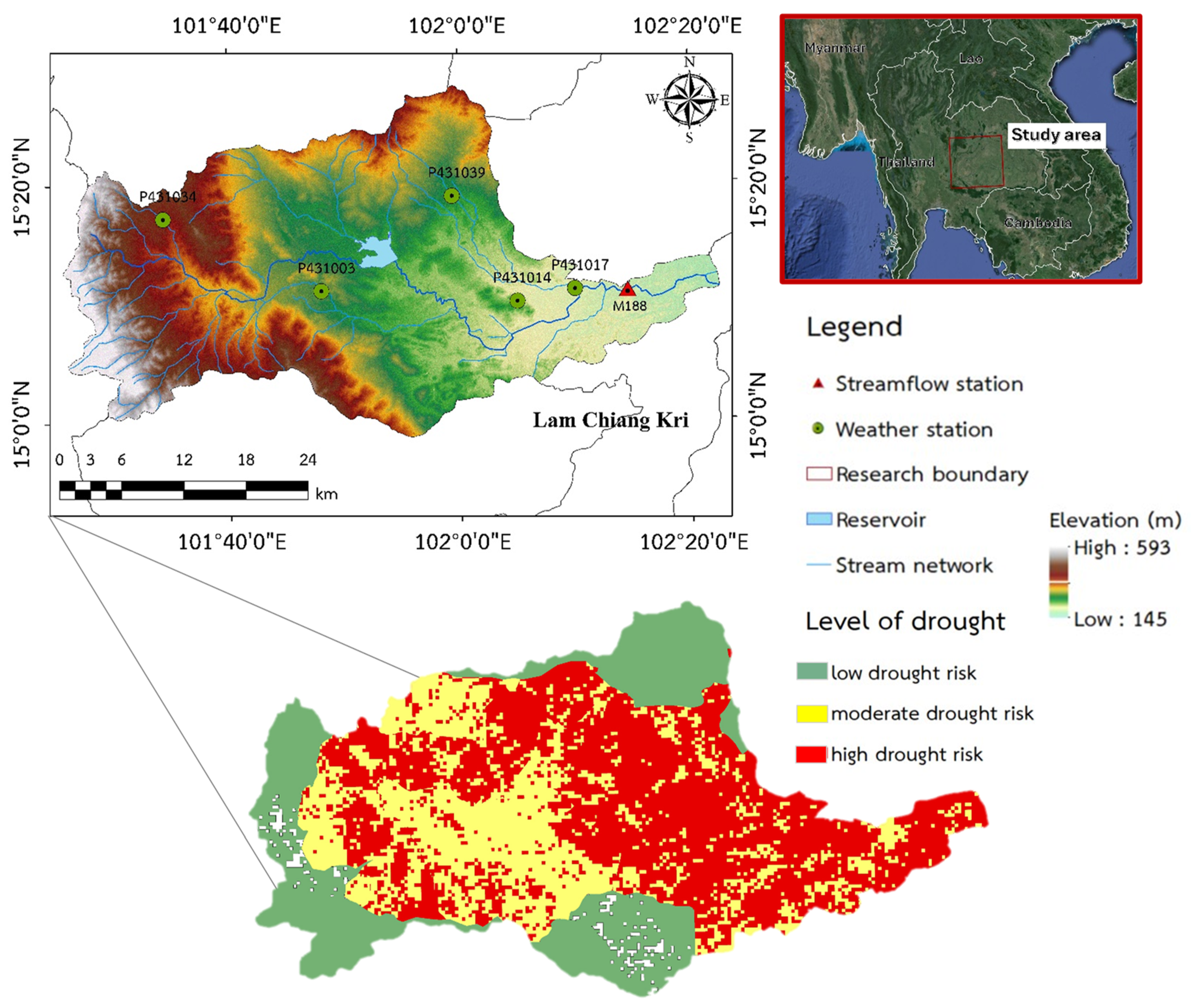
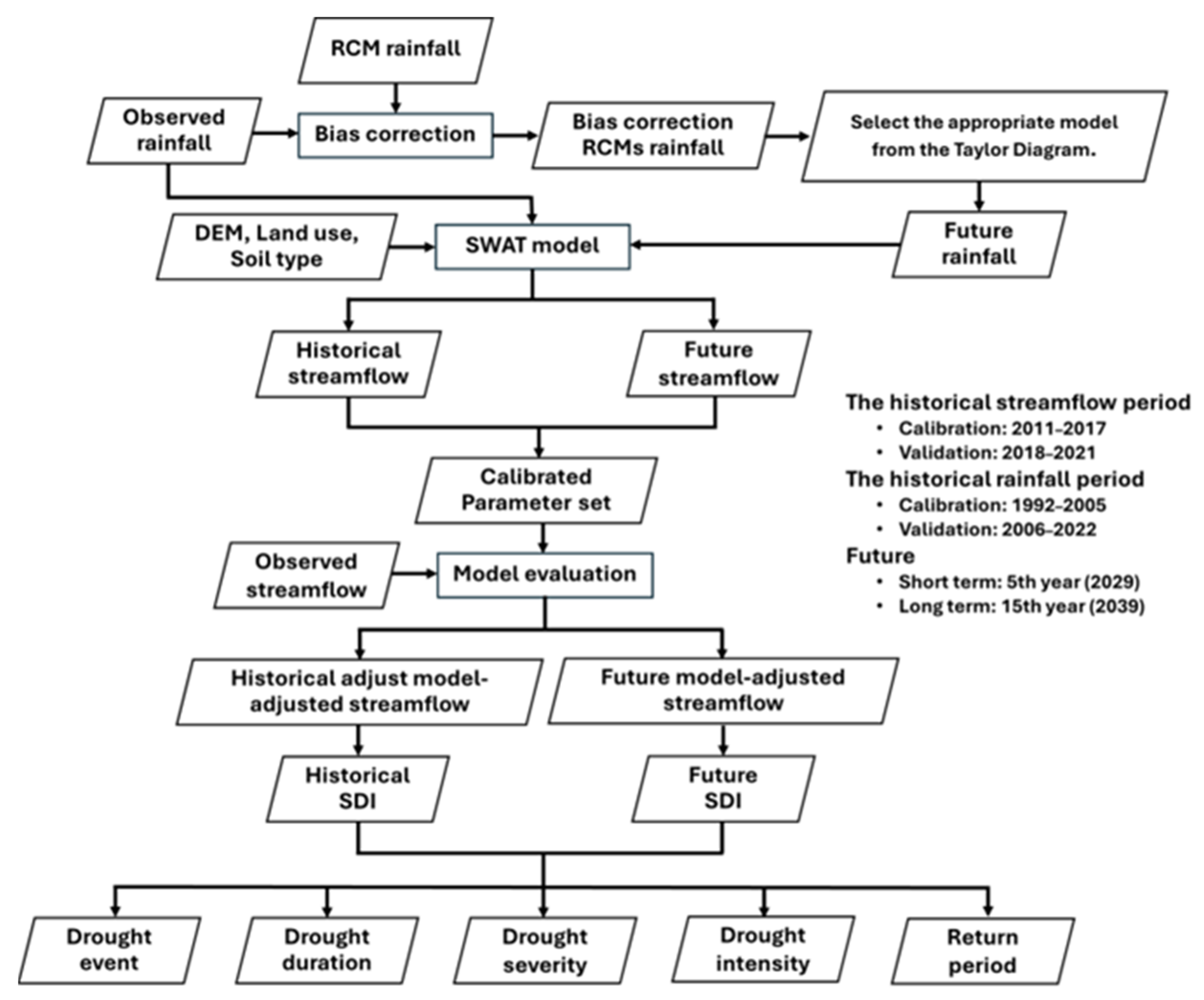
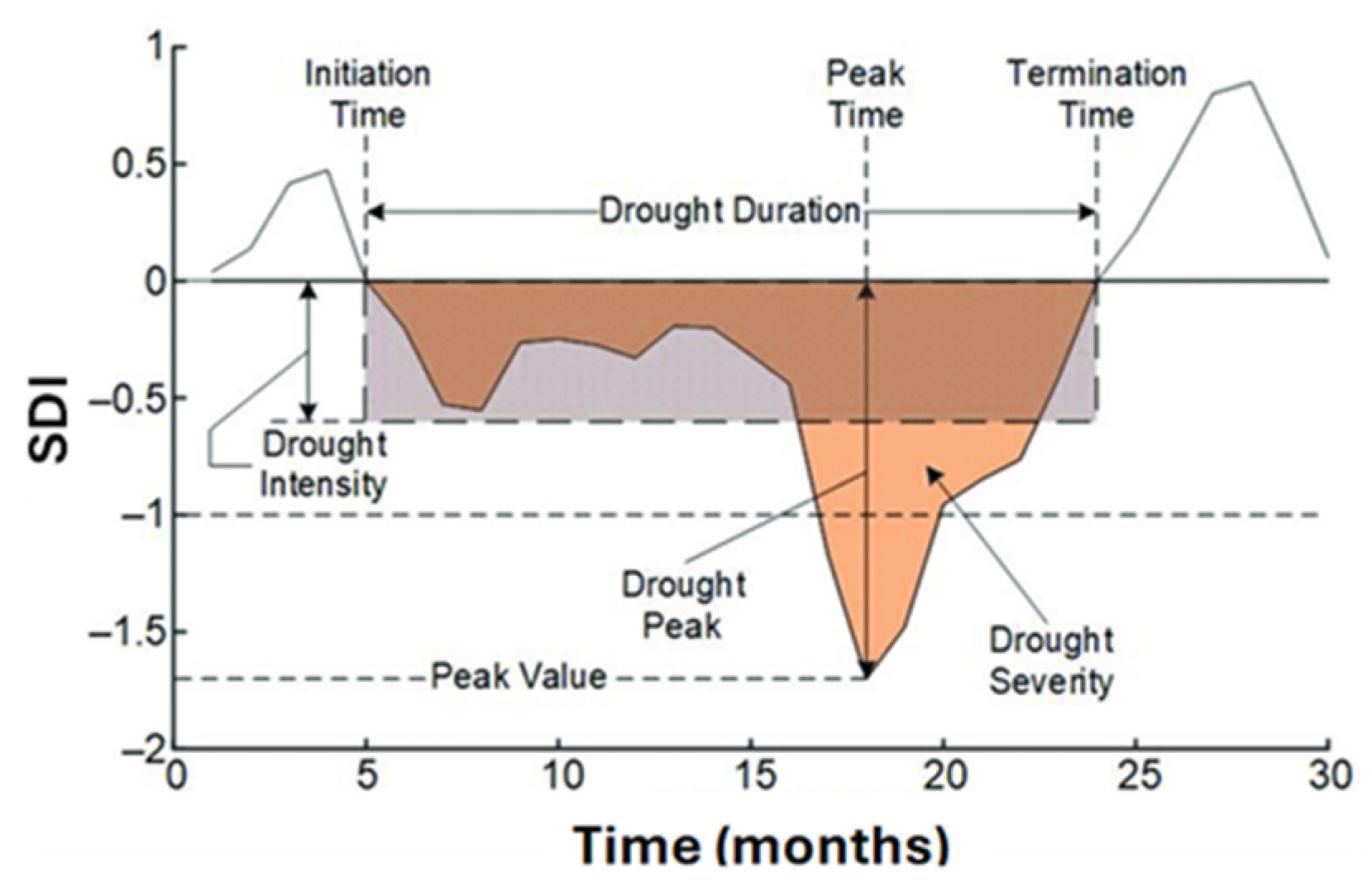

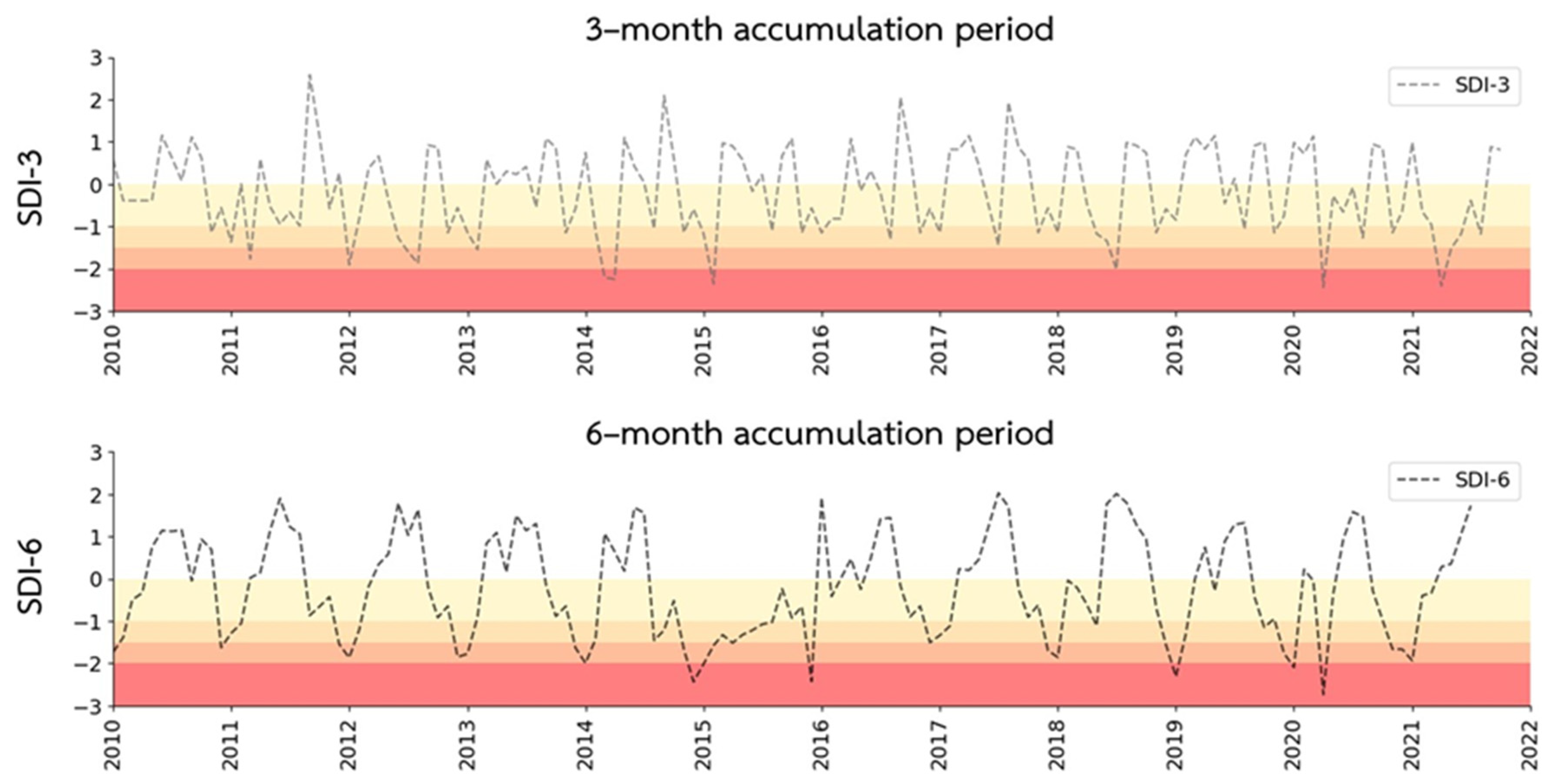
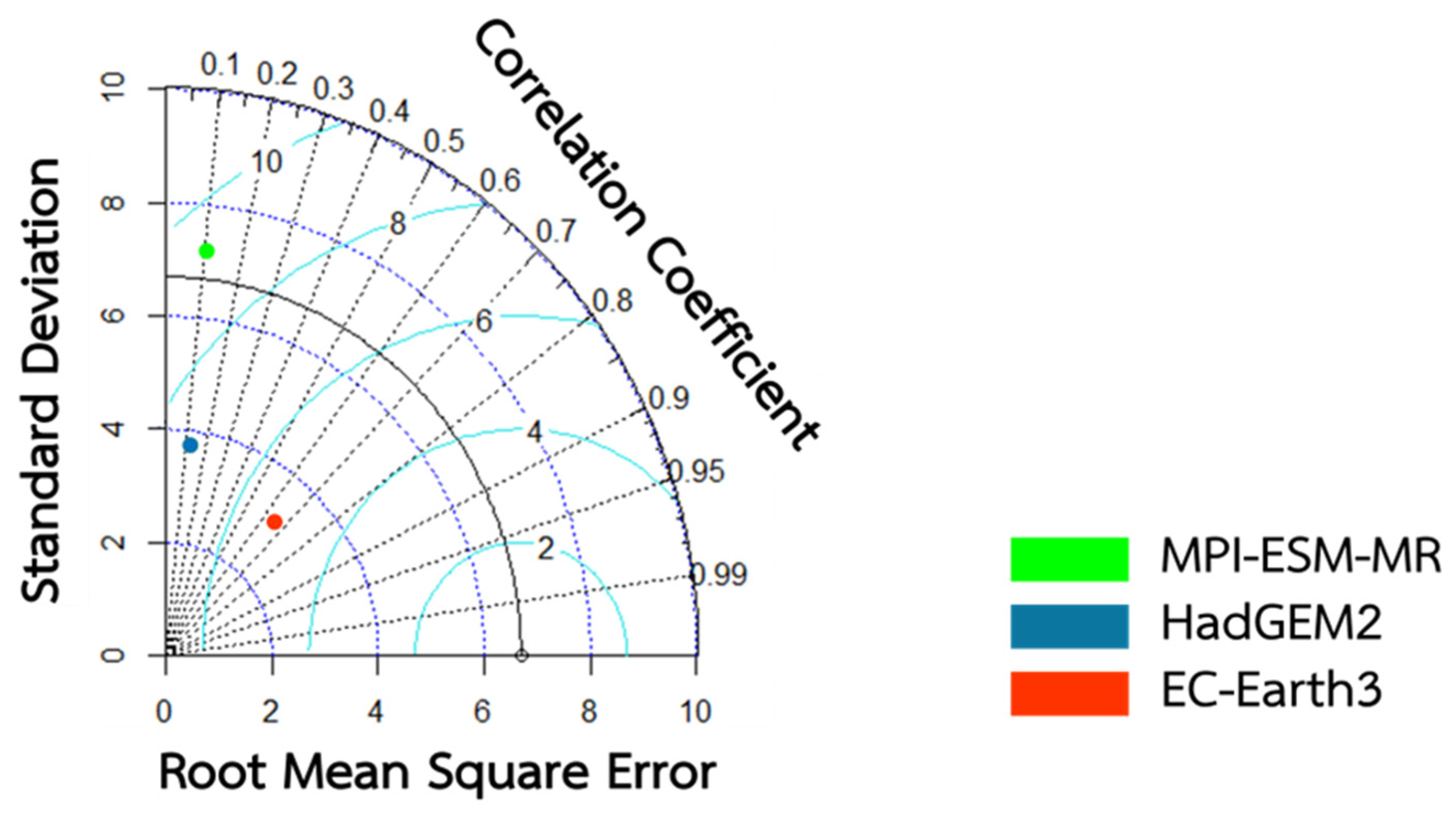


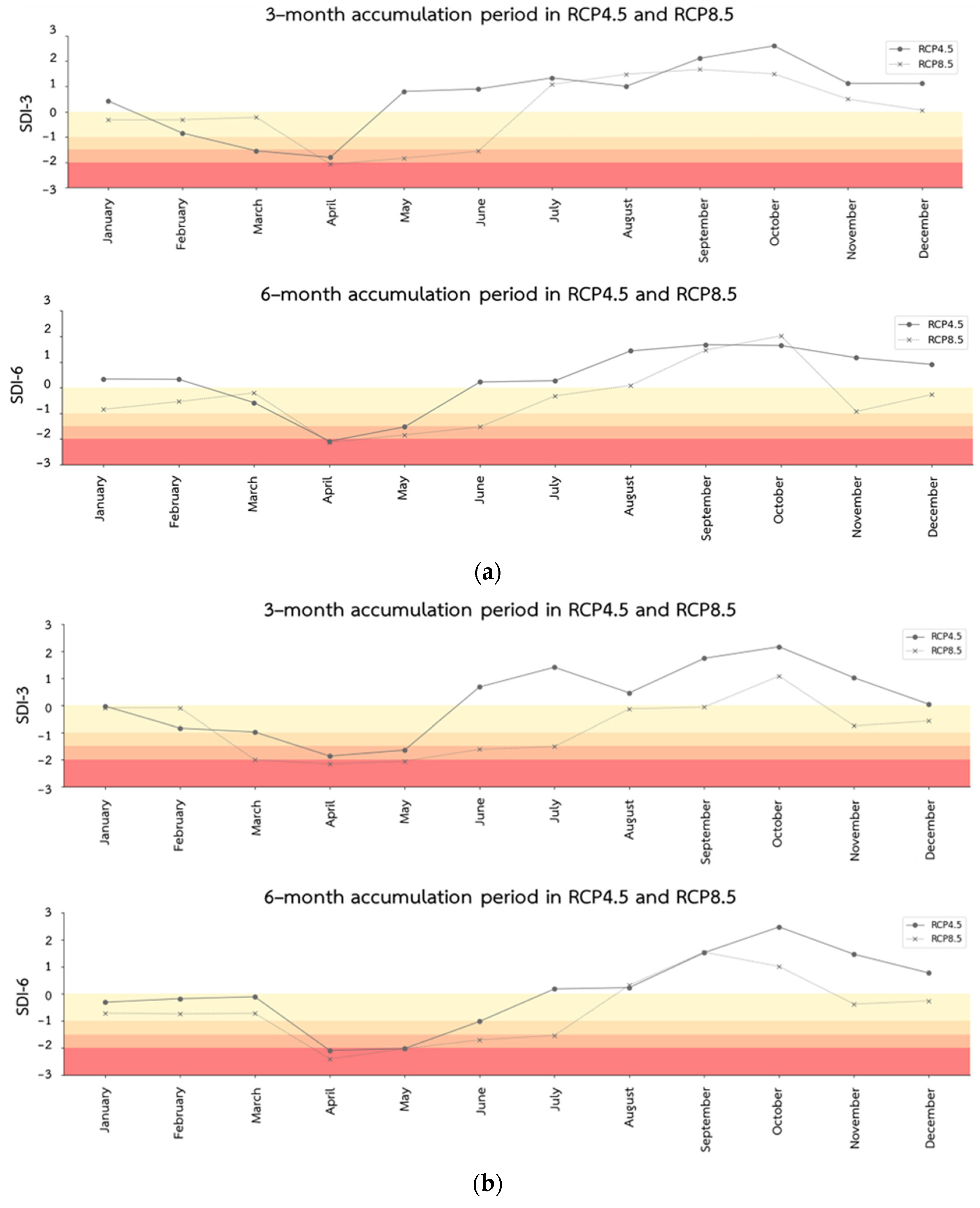
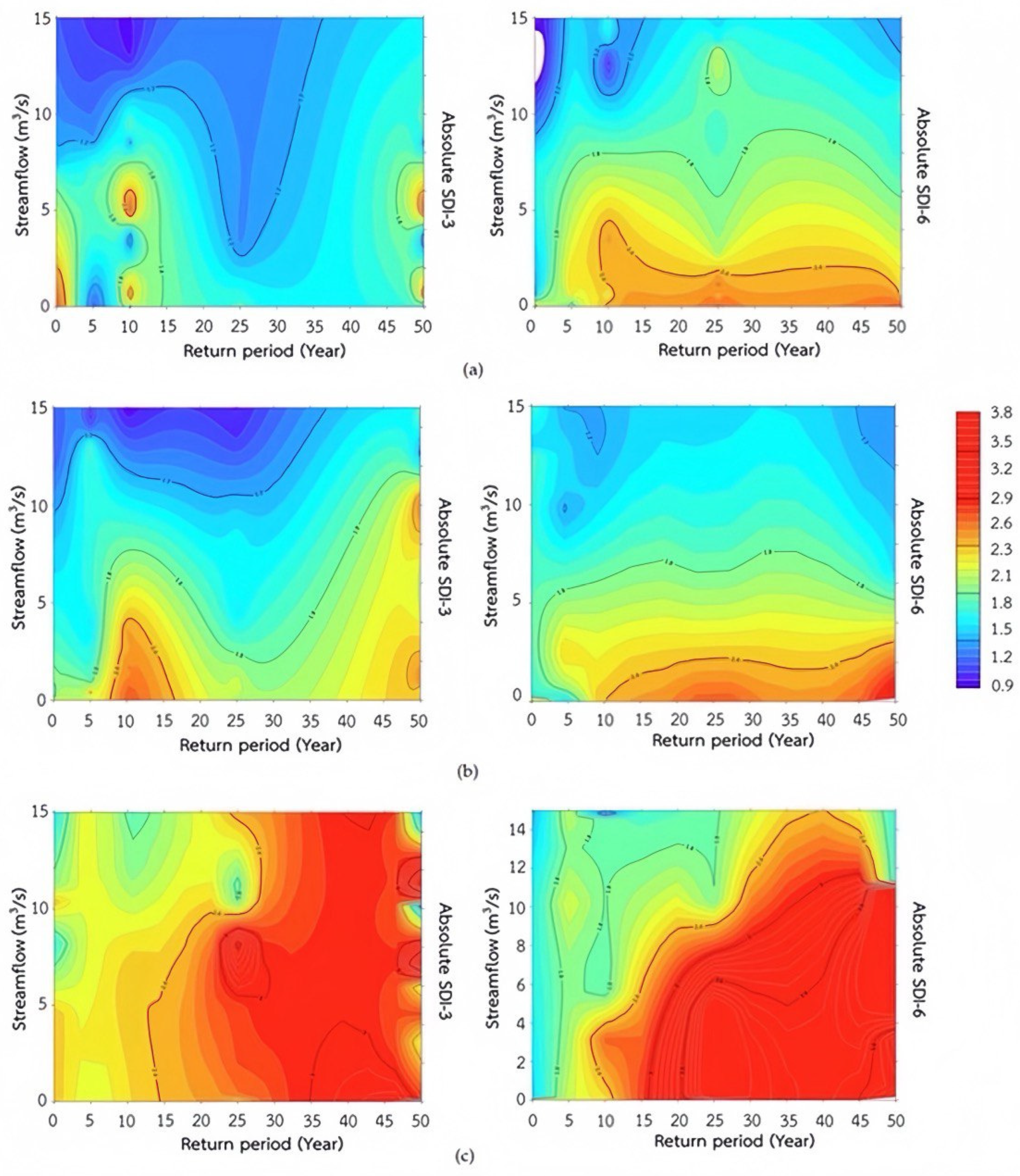
| State | Description | Range |
|---|---|---|
| 1 | No drought | 0 ≤ SDI |
| 2 | Mild drought | −1 ≤ SDI < 0 |
| 3 | Moderate drought | −1.5 ≤ SDI < −1 |
| 4 | Severe drought | −2 ≤ SDI < −1.5 |
| 5 | Extreme drought | SDI ≤ −2 |
| Parameter | t-Stat | p-Value | Fit Value | Min Value | Max Value |
|---|---|---|---|---|---|
| 1: R__CN2.mgt | −5.48 | 0.01 | 40.395 | 35 | 100 |
| 2: R__SOL_AWC(..).sol | −2.84 | 0.04 | 0.343 | −0.2 | 0.4 |
| 3: R__ESCO.hru | 2.16 | 0.08 | 0.21525 | 0.1 | 0.35 |
| 4: V__GW_DELAY.gw | 1.82 | 0.14 | 155.5 | 0 | 500 |
| 5: R__SLSUBBSN.hru | −1.71 | 0.17 | 56.90 | 50 | 150 |
| Statistic Parameters | Calibration (2011–2017) | Validation (2018–2021) | Total (2011–2021) |
|---|---|---|---|
| R2 | 0.83 | 0.81 | 0.82 |
| NSE | 0.78 | 0.78 | 0.78 |
| PBIAS | 12.0 | 28.04 | 20.02 |
| KGE | 0.64 | 0.46 | 0.55 |
| Hydrological Drought | ||
|---|---|---|
| SDI-3 | SDI-6 | |
| Average drought event (time/year) | 2.67 | 1.25 |
| Total number of drought events (times) | 32 | 15 |
| Maximum drought duration (months) | 23 | 36 |
| Maximum drought severity | −31.97 | −43.04 |
| Maximum drought intensity based on DI1 | −2.44 | −2.74 |
| Maximum drought intensity based on DI2 | −1.35 | −1.69 |
| Time | Baseline (2004–2022) | RCP4.5 | RCP8.5 | ||
|---|---|---|---|---|---|
| (mm) | (mm) | % Change | (mm) | % Change | |
| 2029 | 947.64 | 1311.94 | 38.44 | 892.97 | −5.77 |
| 2039 | 947.64 | 1101.06 | 16.19 | 805.46 | −15.00 |
| Months | Baseline (m3/s) | Future Streamflow (m3/s) | ||||
|---|---|---|---|---|---|---|
| RCP4.5 | RCP8.5 | |||||
| 2029 | 2039 | 2029 | 2039 | |||
| Observation | Simulation | Simulation | Simulation | Simulation | Simulation | |
| January | 45.96 | 46.59 | 60.83 | 45.78 | 4.94 | 4.94 |
| February | 19.30 | 19.30 | 1.20 | 10.92 | 0.00 | 5.76 |
| March | 9.77 | 10.66 | 0.13 | 9.66 | 0.00 | 6.69 |
| April | 24.54 | 25.14 | 0.13 | 9.66 | 0.19 | 0.19 |
| May | 62.52 | 63.23 | 12.08 | 6.08 | 0.07 | 116.05 |
| June | 122.29 | 123.02 | 30.30 | 7.45 | 0.33 | 128.14 |
| July | 205.78 | 206.47 | 46.95 | 15.21 | 4.57 | 114.43 |
| August | 329.76 | 330.48 | 249.36 | 159.97 | 80.37 | 378.82 |
| September | 626.43 | 671.42 | 624.79 | 474.93 | 225.28 | 325.10 |
| October | 652.15 | 653.03 | 1495.52 | 1495.52 | 708.20 | 65.79 |
| November | 419.28 | 419.99 | 691.80 | 593.66 | 421.28 | 10.70 |
| December | 143.72 | 119.69 | 410.01 | 363.35 | 247.15 | 30.93 |
| Total runoff | 2661.51 | 2689.02 | 3623.09 | 3192.18 | 1692.38 | 1187.54 |
| Wet period (m3/s) | 2442.76 | 2492.78 | 3150.93 | 2762.47 | 1440.29 | 1139.21 |
| Dry period (m3/s) | 218.74 | 196.24 | 472.17 | 429.71 | 252.09 | 48.33 |
| (%) Percentage change | - | - | 34.74 | 18.71 | −37.06 | −55.84 |
Disclaimer/Publisher’s Note: The statements, opinions and data contained in all publications are solely those of the individual author(s) and contributor(s) and not of MDPI and/or the editor(s). MDPI and/or the editor(s) disclaim responsibility for any injury to people or property resulting from any ideas, methods, instructions or products referred to in the content. |
© 2024 by the authors. Licensee MDPI, Basel, Switzerland. This article is an open access article distributed under the terms and conditions of the Creative Commons Attribution (CC BY) license (https://creativecommons.org/licenses/by/4.0/).
Share and Cite
Chatklang, S.; Tongdeenok, P.; Kaewjampa, N. Investigating Hydrological Drought Characteristics in Northeastern Thailand in CMIP5 Climate Change Scenarios. Atmosphere 2024, 15, 1136. https://doi.org/10.3390/atmos15091136
Chatklang S, Tongdeenok P, Kaewjampa N. Investigating Hydrological Drought Characteristics in Northeastern Thailand in CMIP5 Climate Change Scenarios. Atmosphere. 2024; 15(9):1136. https://doi.org/10.3390/atmos15091136
Chicago/Turabian StyleChatklang, Sornsawan, Piyapong Tongdeenok, and Naruemol Kaewjampa. 2024. "Investigating Hydrological Drought Characteristics in Northeastern Thailand in CMIP5 Climate Change Scenarios" Atmosphere 15, no. 9: 1136. https://doi.org/10.3390/atmos15091136
APA StyleChatklang, S., Tongdeenok, P., & Kaewjampa, N. (2024). Investigating Hydrological Drought Characteristics in Northeastern Thailand in CMIP5 Climate Change Scenarios. Atmosphere, 15(9), 1136. https://doi.org/10.3390/atmos15091136






